9 Worst Foods That Can Lead to Belly Fat
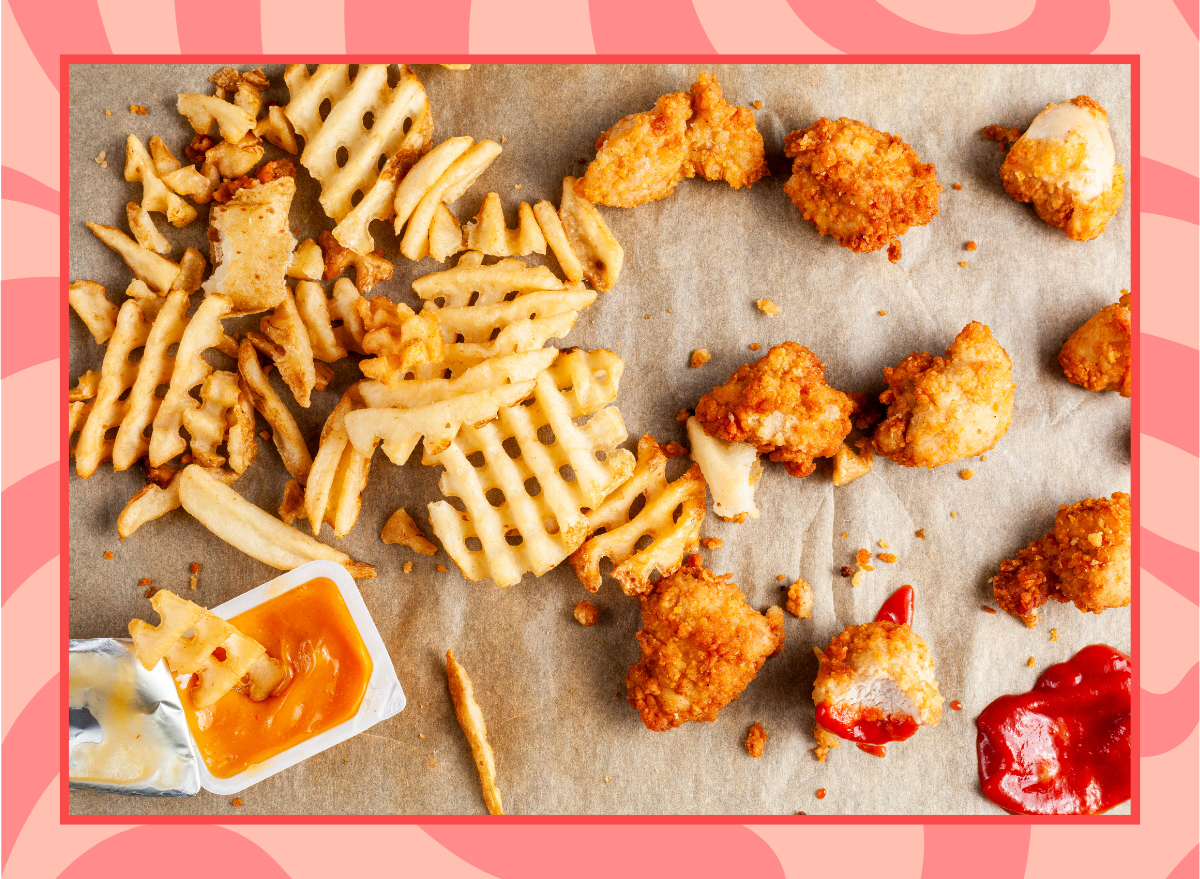
If your goal is to lose weight around your stomach, it's important to know there's no quick fix to target belly fat. Healthy, sustainable belly fat loss requires a holistic approach that considers factors like exercise, stress, alcohol consumption, and overall lifestyle. When it comes to your diet specifically, avoiding or limiting certain foods that can contribute to belly fat is a key part of achieving your goals.
Foods that contribute to belly fat are often high in added sugars and trans fats, such as fast food, packaged baked goods, and candy.
"One study published in the journal Obesity Reviews found that people who over-consume calories and hyper-palatable foods (those that are both highly processed and intensely flavorful) are more likely to have excess abdominal fat," says Noah Quezada, RDN. "In fact, the study showed that these foods may be more responsible for abdominal obesity than any other factor."
Read on to discover the worst foods for belly fat, according to dietitians and research. Then, for more healthy eating tips, check out 8 Best Vegetables To Shrink Belly Fat.
Processed Meats
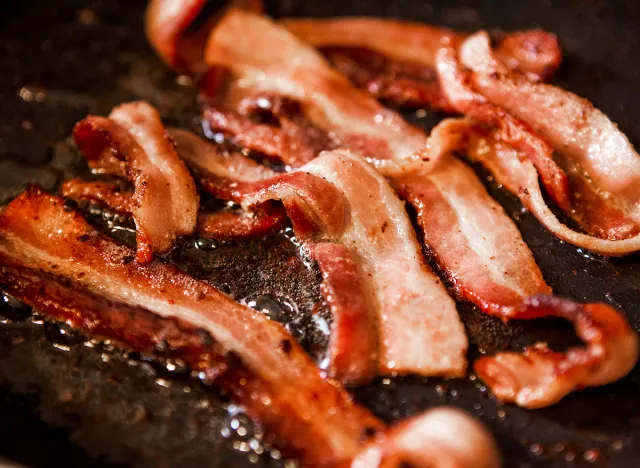
Increasingly, research has shown that processed meats, such as pepperoni, sausage, deli meats, and bacon have some major drawbacks for your health.
Not only can they increase your risk for colorectal cancer, but they can also increase the inches on your waistline. Studies have found that a diet low in processed meats and other processed foods (and high in fruit and dairy) helps prevent the accumulation of abdominal fat.
Translation: Pepperoni pizza on a Friday night is probably fine here and there, but if you're aiming to lose belly weight, think twice before making it a regular choice.
White Bread
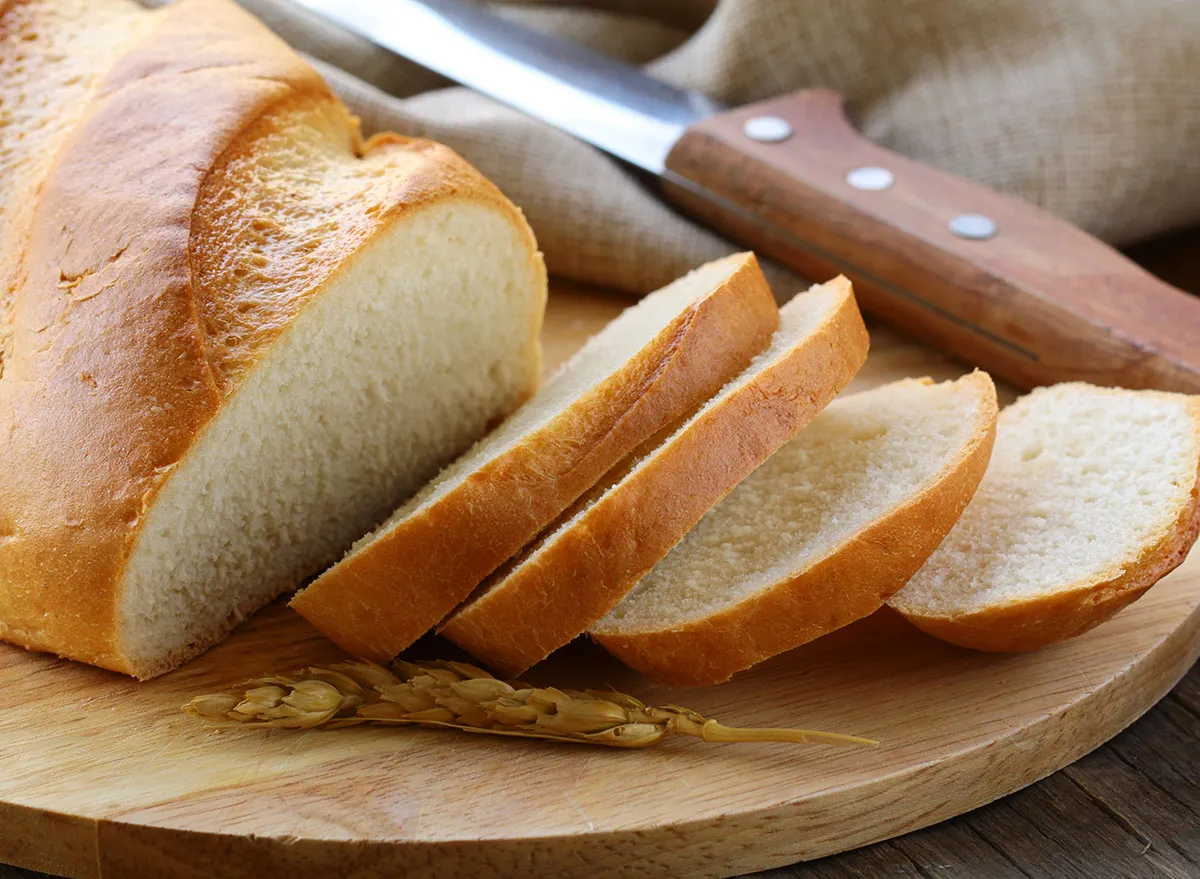
White and refined breads don't have as much fiber and nutrients as their whole-grain counterparts, but the downsides of refined grains don't stop there. A large study of over 2,800 adults found that higher intakes of refined grains, like those in white bread, were associated with higher visceral (aka belly) fat.
Whenever possible, opt for whole wheat bread over white. Their higher fiber and grain counts will keep you fuller longer, which may also aid your weight loss efforts.
Candy
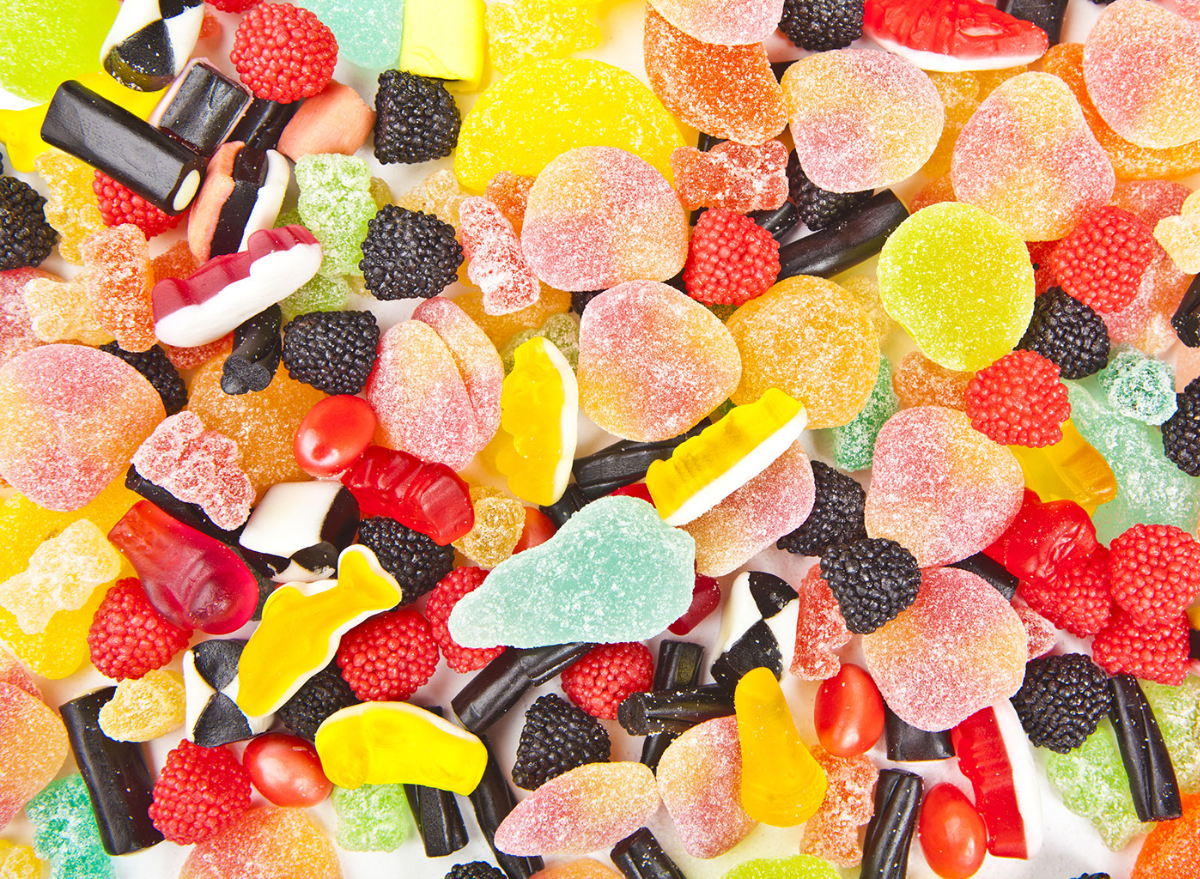
This one shouldn't come as a surprise. To minimize belly fat, keep your distance from the candy bowl! With loads of un-filling simple carbs, it's all too easy to overdo it on sugary sweets like fruity or chocolatey candies.
"These foods may contribute to belly fat accumulation if they are eaten in excess and aren't being used as energy," says Lauren Manaker, MS, RDN. "Carbs are primarily an energy source, but if they aren't used up, they will be stored as fat—possibly in the belly area."
One thing that makes excess candy so bad for abdominal fat is that they are high in added sugars and low in fiber or protein. This means you're consuming empty calories that won't fill you up, and research shows that there is a connection between too much added sugar and abdominal fat gain.
Some Bottled Salad Dressings

If you're eating plenty of salads during the week but still gaining weight, the culprit may be the salad dressing you're choosing.
"Not all salad dressing is healthy and many types can increase the calorie and fat content of your salad without you noticing, which can lead to abdominal weight gain and stall weight loss efforts," says Trista Best, MPH, RD, LD at Balance One Supplements.
According to Harvard Health, replacing saturated fats and trans fats with more polyunsaturated fats (as part of a balanced diet) can help lower abdominal fat. Many bottled salad dressings are high in trans and saturated fats, so replacing these with polyunsaturated-based dressings like olive oil can help. "When choosing a salad dressing, opt for vinegar, balsamic options, or a squeeze of lemon for flavor," adds Best.
Meal Replacement Bars
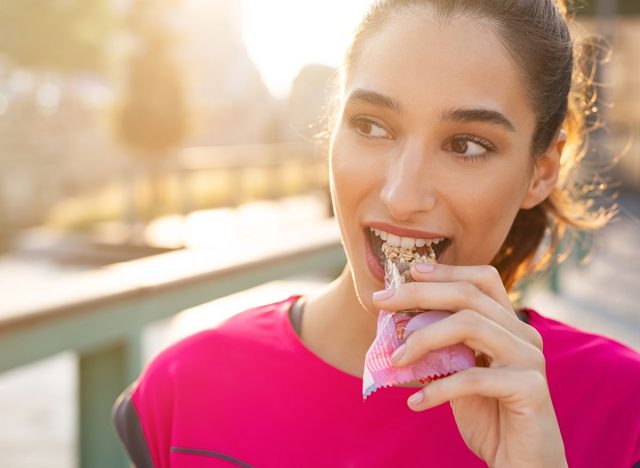
They're marketed as being "healthy," but meal-replacement bars are often heavily processed and full of added sugars, and can leave you feeling hungrier than before.
"These bars can be a healthy addition to a weight loss diet, but when we don't give weight to the quality of nutrients, they can actually encourage abdominal weight gain," says Best. "Processed meal replacement bars are often high in calories, fats, sodium, added sugar, and refined carbohydrates. Just one of these factors can contribute to abdominal weight gain, but most often meal replacement bars have nearly all of these weight-promoting characteristics."
Another problem with using these bars as meal replacements is the potential lack of fiber you'll experience. Every meal during the day is an opportunity to get a serving of fiber, a nutrient that can help reduce abdominal fat. Many meal replacement bars lack this nutrient, meaning you're missing out on an opportunity.
Ice Cream

While we may not want to admit it, consuming ice cream regularly may lead to some unwanted weight gain around the abdominal area.
"Ice cream is another food that can contribute to the accumulation of belly fat because it's loaded with sugar and saturated fat, and it's very easy to overeat," says Quezada.
Studies continue to show that increased added sugar consumption can lead to more abdominal fat, making ice cream a potential culprit. Thankfully, there are plenty of lower-sugar ice cream options you can find at the store.
Sugary Breakfast Cereal
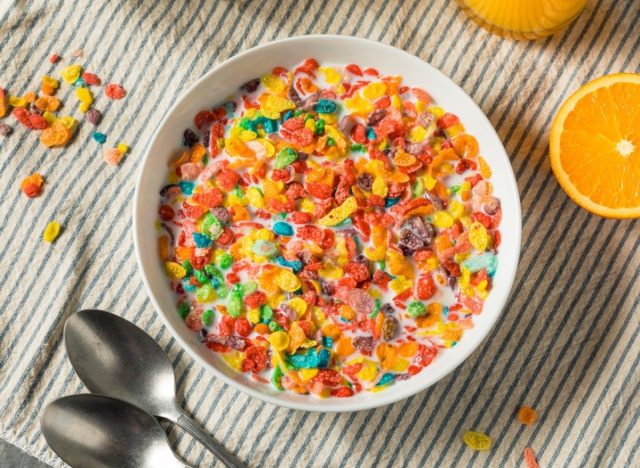
Starting your morning off with a bowl of sugary breakfast cereal may be delicious, but this type of morning meal may contribute to abdominal fat.
Cereals that are high in added sugars can contribute to belly fat because there is a link between excess consumption of added sugar and an increased risk of more fat around your stomach.
Aside from the higher levels of sugar, these cereals normally lack protein and fiber, which means there aren't nutrients to help keep you full or leave you feeling satisfied. This may lead to greater calorie intakes throughout the morning or increased snacking.
Packaged Pastries
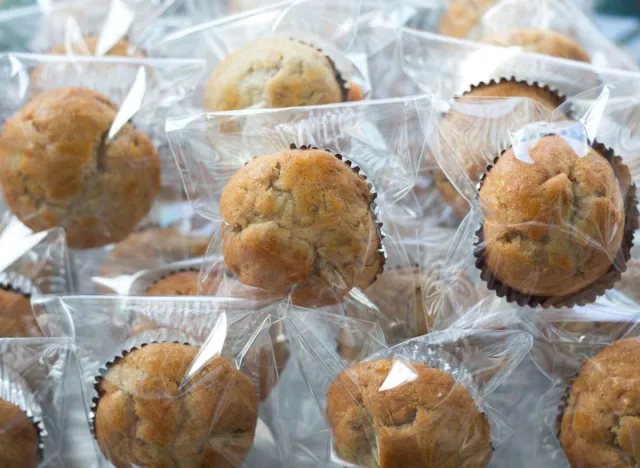
Delicious and convenient as they may be, packaged pastries like danishes, muffins, and donuts commonly harbor high levels of trans fats and added sugars.
One study found that eating bread rolls high in trans fats increased body fat and weight circumference in postmenopausal women who were already overweight. To avoid the intake of trans fats, opt for homemade pastries when you have the time and freeze some to defrost on busier mornings.
Fried Fast Foods
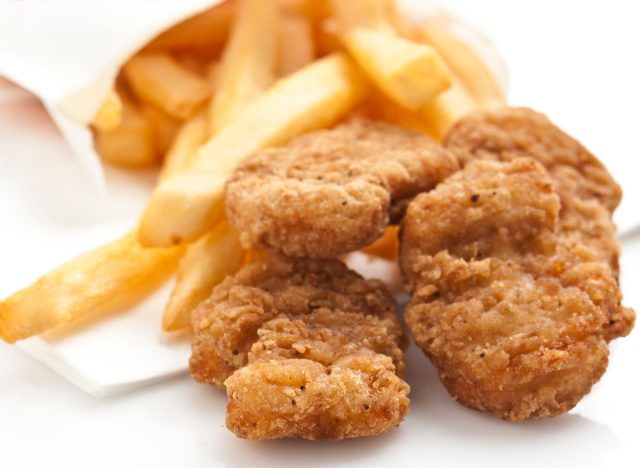
The list of trans fat offenders continues with fried options at fast-food chains, which can lead to more abdominal fat when consumed regularly.
Research shows that corn oils contain more trans fats than other vegetable oils—and, as of 2010, the majority of fast-food chains used corn oil to fry their French fries.
Fast food is considered an "ultra-processed food," which research has shown is linked to an increase in visceral fat—the type of fat found around your abdominal organs. On top of that, a study from the Journal of Preventive Medicine and Hygiene also concluded that fast food can lead to a greater risk for abdominal obesity.
- Source: Johnson F, Wardle J. Variety, palatability, and obesity. Adv Nutr. 2014 Nov 14;5(6):851-9. doi: 10.3945/an.114.007120. PMID: 25398751; PMCID: PMC4224225.
- Source: McKeown NM, Yoshida M, Shea MK, Jacques PF, Lichtenstein AH, Rogers G, Booth SL, Saltzman E. Whole-grain intake and cereal fiber are associated with lower abdominal adiposity in older adults. J Nutr. 2009 Oct;139(10):1950-5. doi: 10.3945/jn.108.103762. Epub 2009 Sep 2. PMID: 19726588; PMCID: PMC2744616.
- Source: Bendsen NT, Chabanova E, Thomsen HS, Larsen TM, Newman JW, Stender S, Dyerberg J, Haugaard SB, Astrup A. Effect of trans fatty acid intake on abdominal and liver fat deposition and blood lipids: a randomized trial in overweight postmenopausal women. Nutr Diabetes. 2011 Jan 31;1(1):e4. doi: 10.1038/nutd.2010.4. PMID: 23154296; PMCID: PMC3302130.
- Source: Song J, Park J, Jung J, Lee C, Gim SY, Ka H, Yi B, Kim MJ, Kim CI, Lee J. Analysis of Trans Fat in Edible Oils with Cooking Process. Toxicol Res. 2015 Sep;31(3):307-12. doi: 10.5487/TR.2015.31.3.307. PMID: 26483890; PMCID: PMC4609978.
- Source: Corn content of French fry oil from national chain vs. small business restaurants
- Source: Konieczna, J., Morey, M., Abete, I., Bes–Rastrollo, M., Ruiz‐Canela, M., Vioque, J., González‐Palacios, S., Daimiel, L., Fiol, M., Martín, V., Estruch, R., Vidal, J., Martínez‐González, M. Á., Canudas, S., Jover, A., Fernández‐Villa, T., Casas, R., Olbeyra, R., Buil‐Cosiales, P., . . . Investigators, P. (2021). Contribution of ultra-processed foods in visceral fat deposition and other adiposity indicators: Prospective analysis nested in the PREDIMED-Plus trial. Clinical Nutrition, 40(6), 4290–4300. https://doi.org/10.1016/j.clnu.2021.01.019
- Source: Mohammadbeigi A, Asgarian A, Moshir E, Heidari H, Afrashteh S, Khazaei S, Ansari H. Fast food consumption and overweight/obesity prevalence in students and its association with general and abdominal obesity. J Prev Med Hyg. 2018 Sep 28;59(3):E236-E240. doi: 10.15167/2421-4248/jpmh2018.59.3.830. PMID: 30397681; PMCID: PMC6196377.









